Direct Inversion Method of Fault Slip Analysis to Determine the Orientation of Principal Stresses and Relative Chronology for Tectonic Events in Southwestern White Mountain Region of New Hampshire, USA
Abstract
1. Introduction
2. Geologic and Tectonic History of the Southwestern White Mountain Region
3. Data Collection and Stress Inversion Method of Analysis
4. Results
4.1. Event 1—Regime 1
4.2. Event 2—Regimes 2 and 3
4.3. Event 3—Regime 4
4.4. Event 3—Regime 5
4.5. Event 4—Regimes 6, 7 and 8
4.6. Event 5—Regime 9
5. Interpretation
5.1. Event 1—Acadian Compression
5.2. Event 2—Post Acadian Extension
5.3. Event 3—Late Alleghenian Compression
5.4. Event 4—Atlantic Extensional Opening (?)
5.5. Event 5—Recent or Present
6. Discussion
Author Contributions
Funding
Acknowledgments
Conflicts of Interest
Data Availability
Appendix A. List of Data Collected in This Study
- Explanation to Columns in Table A1
- Column A–Fault Reference Number
- Column B–Fault Strike (azimuth)
- Column C–Fault Dip and Direction
- Column D–Rake of Slip Striations
- Column E–Regime Number/Relative Chronology (1 = oldest, 9 = youngest)
- Certainty (C = certain, P = probable, S = inferred)
- Column F–Fault Location on Interstate 93:
- Column G–Fracture Reference Numbers on [10] sheet 2
- Column H–Site location (see Figure 1)
| A | B | C | D | E | F | G | H |
|---|---|---|---|---|---|---|---|
| 1 | 173 | 77W | 43N | 6C | SBLE | 1 | 1 |
| 2 | 41 | 40E | 45N | 2C 4C | SBLE | 42 | 1 |
| 3 | 32 | 38E | 62N | 2C 4C | SBLE | 42 | 1 |
| 4 | 95 | 64N | 40W | 1C 1C | SBLE | 42A | 1 |
| 5 | 163 | 83W | 40N | 6C | SBLE | 11A | 1 |
| 6 | 163 | 83W | 40N | 1C | SBLE | 11 | 1 |
| 7 | 166 | 85W | 44N | 6C | SBLE | 11A | 1 |
| 8 | 165 | 83W | 38N | 6C | SBLE | 11A | 1 |
| 9 | 159 | 77W | 9S | 7C | SBLE | 19 | 1 |
| 10 | 152 | 88W | 20S | 7C | SBLE | 14B | 1 |
| 11 | 159 | 78W | 17S | 7C | SBLE | 14B′ | 1 |
| 12 | 153 | 89W | 34S | 7C | SBLE | 22 | 1 |
| 13 | 137 | 89W | 41S | 7C | SBLE | 22 | 1 |
| 14 | 153 | 77W | 46S | 7C | SBLE | 22 | 1 |
| 15 | 165 | 84W | 46S | 7C | SBLE | 22′ | 1 |
| 16 | 146 | 81W | 25S | 7C | SBLE | 21 | 1 |
| 17 | 141 | 88W | 43S | 7C | SBLE | 21 | 1 |
| 18 | 139 | 88W | 36S | 7C | SBLE | 20 | 1 |
| 19 | 136 | 77W | 33S | 7C | SBLE | 20 | 1 |
| 20 | 158 | 76W | 24S | 7C | SBLE | 19′ | 1 |
| 21 | 3 | 69W | 31S | 7C | SBLE | unmapped | 1 |
| 22 | 157 | 77W | 23S | 7C | SBLE | 19′ | 1 |
| 23 | 3 | 69W | 31S | 7C | SBLE | unmapped | 1 |
| 24 | 55 | 48N | 52W | 3C | SBLE | unmapped ou 18A | 1 |
| 25 | 61 | 46N | 47W | 3C | SBLE | unmapped ou 18A | 1 |
| 26 | 48 | 77N | 76W | 3C | SBLE | unmapped ou 18A | 1 |
| 27 | 29 | 63W | 73S | 3C | SBLE | 24 | 1 |
| 28 | 28 | 52E | 68S | 1C | SBLE | 25 | 1 |
| 29 | 47 | 87S | 29W | 7C | SBLE | unmapped | 1 |
| 30 | 42 | 88E | 3S | 1C 7C | SBLE | unmapped | 1 |
| 31 | 177 | 42E | 61N | 2C 4C | SBLE | 48 | 1 |
| 32 | 178 | 44E | 21S | 1C 7C | SBLE | 48 | 1 |
| 33 | 178 | 44E | 60N | 2C 4C | SBLE | 48 | 1 |
| 34 | 18 | 48E | 51S | 3C | SBLE | 49 | 1 |
| 35 | 26 | 77E | 25N | 1C 6C | SBLE | 67 | 1 |
| 36 | 26 | 77E | 79S | 2C 3C | SBLE | 67 | 1 |
| 37 | 13 | 51E | 37S | 3C | SBLE | 98? | 1 |
| 38 | 12 | 88W | 12S | 7C | SBLE | unmapped | 1 |
| 39 | 176 | 60E | 46N | 6C | SBLE | unmapped | 1 |
| 40 | 48 | 87N | 7E | 1C 5C | SBLE | 107 | 1 |
| 41 | 48 | 87N | 75E | 2C 3C | SBLE | 107 | 1 |
| 42 | 30 | 87E | 82N | 3C | SBLE | 106 | 1 |
| 43 | 41 | 78E | 17N | 5C | SBLE | 116A proche | 1 |
| 184 | 43 | 80E | 15N | 5C | SBLE | 116A proche | 1 |
| 182 | 28 | 70W | 23S | 7C | SBLE | 116 | 1 |
| 183 | 41 | 75E | 74S | 3C | SBLE | 116 | 1 |
| 44 | 54 | 87N | 29W | 5C | SBLE | 116 | 1 |
| 45 | 32 | 66E | 33S | 5C | SBLE | unmapped | 1 |
| 46 | 30 | 71E | 81N | 3C | SBLE | 123 | 1 |
| 47 | 30 | 71E | 18N | 5C | SBLE | 123 | 1 |
| 48 | 39 | 72E | 83S | 3C | SBLE | unmapped | 1 |
| 49 | 51 | 84S | 72W | 1C 3C | SBLE | 130 | 1 |
| 50 | 18 | 20W | 53N | 2C 1C | SBLE | 138 | 1 |
| 51 | 51 | 84S | 10E | 1C 5C | SBLE | 130 | 1 |
| 52 | 17 | 21W | 53N | 2C 1C | SBLE | 138 | 1 |
| 53 | 50 | 83S | 73W | 3C | SBLE | 130 | 1 |
| 54 | 50 | 83S | 9E | 5C | SBLE | 130 | 1 |
| 55 | 73 | 34S | 63E | 1C | SBLE | unmapped | 1 |
| 56 | 67 | 41S | 66E | 1C | SBLE | 139 | 1 |
| 57 | 59 | 76N | 28E | 5C | SBLE | 146 | 1 |
| 58 | 66 | 63N | 28E | 5C | SBLE | unmapped | 1 |
| 59 | 57 | 76S | 15W | 5C | SBLE | 162 | 1 |
| 60 | 24 | 74E | 12N | 1P 5C | SBLE | 166 | 1 |
| 61 | 24 | 74E | 30N | 2P 7C | SBLE | 166 | 1 |
| 62 | 24 | 74E | 64S | 1P 3C | SBLE | 166 | 1 |
| 63 | 25 | 75E | 30N | 2P 6C | SBLE | 166 | 1 |
| 64 | 47 | 87N | 22E | 6C | SBLW | 66 | 1 |
| 65 | 96 | 89S | 67E | 1C | SBLW | 49 | 1 |
| 66 | 57 | 86S | 37E | 5C | SBLW | 48 | 1 |
| 67 | 17 | 88E | 73S | 3C | SBLE | unmapped | 1 |
| 68 | 25 | 56W | 61S | 2C 1C | SBLW | 25 | 1 |
| 69 | 25 | 56W | 62N | 1C 1C | SBLW | 25 | 1 |
| 70 | 25 | 56W | 16S | 2C 5C | SBLW | 25 | 1 |
| 71 | 25 | 54W | 64N | 1C 1C | SBLW | 25 | 1 |
| 72 | 71 | 33N | 82E | 1C 8C | SBLW | 24 | 1 |
| 73 | 71 | 33N | 42E | 2C 6C | SBLW | 24 | 1 |
| 74 | 52 | 32N | 63E | 8C | SBLW | 24 | 1 |
| 75 | 76 | 22S | 58E | 1C 8C | SBLW | 24 | 1 |
| 76 | 71 | 31N | 82E | 2C 8C | SBLW | 24 | 1 |
| 77 | 78 | 21S | 84E | 8C | SBLW | 24 | 1 |
| 78 | 75 | 23S | 88E | 8C | SBLW | 24 | 1 |
| 79 | 7 | 70E | 62S | 3C | SBLW | unmapped | 1 |
| 80 | 10 | 43E | 76S | 3C | SBL | unreferenced | 1 |
| 81 | 29 | 71W | 24N | 5C | NBLW | 1 | 1 |
| 82 | 37 | 76W | 29N | 5C | NBLW | 1 | 1 |
| 83 | 42 | 74W | 35N | 5C | NBLW | 1 | 1 |
| 84 | 48 | 72N | 12E | 5C | NBLW | 1 | 1 |
| 85 | 142 | 19W | 85S | 4C | NBLW | unmapped | 1 |
| 86 | 68 | 33S | 64E | 3C | NBLW | 9 | 1 |
| 87 | 69 | 35S | 37E | 3C | NBLW | 1 | |
| 88 | 46 | 52S | 63E | 3C | NBLW | 12-11月 | 1 |
| 89 | 52 | 47S | 63E | 3C | NBLW | 12-11月 | 1 |
| 90 | 51 | 38S | 52E | 3C | NBLW | 12 | 1 |
| 91 | 46 | 42S | 84E | 3C | NBLW | 13 | 1 |
| 92 | 45 | 44S | 83E | 3C | NBLW | 13 | 1 |
| 93 | 14 | 20E | 73S | 3C | NBLW | near F29 | 1 |
| 94 | 22 | 25E | 85S | 3C | NBLW | near F29 | 1 |
| 95 | 21 | 33E | 74S | 1C | NBLW | 28 | 1 |
| 96 | 21 | 54E | 72S | 1C | NBLW | 28 | 1 |
| 97 | 58 | 33S | 67E | 1C | NBLW | unmapped | 1 |
| 98 | 46 | 58S | 66E | 3C | NBLW | unmapped | 1 |
| 99 | 41 | 27E | 77N | 1C | NBLW | 35 | 1 |
| 100 | 29 | 50E | 72N | 3C | NBLW | 71 | 1 |
| 101 | 31 | 81E | 18S | 5C | NBLW | 73 | 1 |
| 102 | 67 | 81N | 6E | 7C | NBLW | unmapped | 1 |
| 103 | 38 | 89E | 9S | 7C | NBLW | unmapped | 1 |
| 104 | 24 | 54E | 64S | 3C | NBLW | 79 | 1 |
| 105 | 15 | 30E | 73S | 3C | NBLW | 79 | 1 |
| 106 | 10 | 36E | 68S | 3C | NBLW | 79 | 1 |
| 107 | 29 | 46E | 87S | 3C | NBLW | 80 | 1 |
| 108 | 29 | 48E | 89S | 3C | NBLW | 80 | 1 |
| 135 | 29 | 48E | 88S | 1C | NBLW | 80 | 1 |
| 109 | 110 | 69N | 11E | 9C | NBLW | unmapped | 1 |
| 110 | 139 | 89E | 19S | 9C | NBLW | unmapped | 1 |
| 111 | 20 | 85W | 12N | 5C | NBLW | 1 | |
| 112 | 165 | 57W | 60S | 3C | NBLW | 1 | |
| 113 | 63 | 86N | 1W | 5C | NBLW | 1 | |
| 114 | 21 | 65E | 76N | 3C | NBLW | 86 | 1 |
| 115 | 160 | 83E | 4S | 7C | NBLW | 122? | 1 |
| 116 | 161 | 80E | 14S | 7C | NBLW | 123? | 1 |
| 117 | 150 | 75E | 10S | 7C | NBLW | 123? | 1 |
| 118 | 166 | 84E | 7S | 7C | NBLW | 118 | 1 |
| 119 | 25 | 83E | 2N | 7C | NBLW | unmapped | 1 |
| 120 | 177 | 76E | 2S | 7C | NBLW | unmapped | 1 |
| 121 | 26 | 51E | 64N | 3C | NBLW | unmapped | 1 |
| 122 | 1 | 82E | 2S | 7C | NBLW | 130? | 1 |
| 123 | 170 | 86E | 7S | 7C | NBLW | 133? | 1 |
| 124 | 4 | 82E | 1N | 7C | NBLW | 131? | 1 |
| 125 | 14 | 47E | 79S | 3C | NBLW | unmapped | 1 |
| 126 | 47 | 47S | 33E | 5C | NBLW | 135 | 1 |
| 127 | 179 | 62W | 80N | 3C | NBLW | unmapped | 1 |
| 128 | 1 | 67W | 84N | 3C | NBLW | 151 | 1 |
| 129 | 156 | 77W | 2S | 7C | NBLW | unmapped | 1 |
| 130 | 12 | 69W | 87S | 3C | NBLW | 156 | 1 |
| 131 | 33 | 77W | 3S | 7C | NBLW | 156 | 1 |
| 132 | 7 | 57W | 71S | 3C | NBLW | unmapped | 1 |
| 133 | 13 | 64W | 77N | 3C | NBLW | unmapped | 1 |
| 134 | 8 | 55W | 72S | 3C | NBLW | unmapped | 1 |
| 185 | 155 | 62E | 80S | 3C | NBLW | unmapped | 1 |
| 186 | 28 | 82E | 77S | 1C 3C | NBLW | unmapped | 1 |
| 187 | 28 | 82E | 4N | 2C 7C | NBLW | unmapped | 1 |
| 136 | 32 | 79W | 79N | 3C | NBLE | unmapped | 1 |
| 137 | 34 | 72E | 74N | 3C | NBLE | 36 | 1 |
| 138 | 34 | 85E | 8S | 7C | NBLE | large fault | 1 |
| 139 | 36 | 66E | 2N | 7C | NBLE | large fault | 1 |
| 140 | 174 | 75E | 17N | 7C | NBLE | unmapped | 1 |
| 141 | 176 | 83W | 27N | 7C | NBLE | 46 | 1 |
| 142 | 175 | 88E | 15N | 7C | NBLE | 46 | 1 |
| 143 | 178 | 79E | 2S | 7C | NBLE | 53 | 1 |
| 144 | 30 | 39E | 10N | 2C 7C | NBLE | 51 | 1 |
| 145 | 30 | 39E | 75S | 1C 3C | NBLE | 51 | 1 |
| 146 | 32 | 88W | 6N | 7C | NBLE | 55 | 1 |
| 147 | 41 | 86E | 3S | 7C | NBLE | 64 | 1 |
| 148 | 37 | 82W | 1S | 7C | NBLE | 64 | 1 |
| 149 | 17 | 61E | 83S | 3C | NBLE | 58 | 1 |
| 150 | 35 | 73W | 63S | 3C | NBLE | unmapped | 1 |
| 151 | 114 | 84N | 5E | 9C | NBLE | 68 | 1 |
| 152 | 42 | 85E | 1S | 7C | NBLE | 70 | 1 |
| 153 | 50 | 89S | 7W | 7C | NBLE | 74 | 1 |
| 154 | 35 | 82W | 12S | 7C | NBLE | 74 | 1 |
| 155 | 44 | 88E | 6S | 7C | NBLE | 74 | 1 |
| 156 | 40 | 72W | 11S | 7C | NBLE | 87-89 | 1 |
| 157 | 39 | 81W | 1S | 7C | NBLE | 87-89 | 1 |
| 158 | 29 | 85W | 36N | 7C | NBLE | 87-89 | 1 |
| 159 | 10 | 83W | 14N | 7C | NBLE | 87-89 | 1 |
| 160 | 32 | 80E | 84N | 3C | NBLE | 91 | 1 |
| 161 | 29 | 84E | 28N | 7C | NBLE | 91 | 1 |
| 162 | 46 | 72N | 88E | 3C | NBLE | 98 | 1 |
| 163 | 58 | 68S | 76E | 1C 3C | NBLE | 105 | 1 |
| 164 | 58 | 68S | 22E | 2C 7C | NBLE | 105 | 1 |
| 165 | 35 | 42E | 82N | 3C | NBLE | unmapped | 1 |
| 166 | 19 | 73E | 66S | 1C | NBLE | unmapped | 1 |
| 167 | 22 | 47E | 80N | 3C | NBLE | unmapped | 1 |
| 168 | 52 | 73S | 13E | 7C | NBLE | 111 | 1 |
| 169 | 46 | 89N | 12E | 7C | NBLE | 130? | 1 |
| 170 | 36 | 82E | 34N | 2C 7C | NBLE | 136? | 1 |
| 171 | 36 | 82E | 1C 3C | NBLE | 136? | 1 | |
| 172 | 22 | 49W | 64S | 3C | NBLE | unmapped | 1 |
| 173 | 42 | 53W | 53S | 3C | NBLE | 163? | 1 |
| 174 | 25 | 67W | 52S | 3C | NBLE | 164? | 1 |
| 175 | 44 | 67W | 49S | 3C | NBLE | unmapped | 1 |
| 176 | 16 | 49W | 74N | 3C | NBLE | unmapped | 1 |
| 177 | 36 | 87E | 82S | 1C | NBLE | unmapped | 1 |
| 178 | 23 | 52W | 85N | 3C | NBLE | unmapped | 1 |
| 179 | 23 | 62W | 85S | 3C | NBLE | unmapped | 1 |
| 180 | 26 | 65W | 83S | 3C | NBLE | unmapped | 1 |
| 181 | 15 | 42W | 89N | 3C | NBLE | unmapped | 1 |
| 188 | 35 | 77E | 66N | 3C | NBLE | 2 | |
| 189 | 32 | 74E | 88N | 3C | NBLE | 2 | |
| 190 | 33 | 80E | 66N | 3C | NBLE | 2 | |
| 191 | 36 | 72W | 77N | 3C | NBLE | 2 | |
| 192 | 26 | 83W | 77S | 3C | NBLE | 2 | |
| 193 | 146 | 65E | 72N | 2C | NBLE | 2 | |
| 194 | 106 | 44S | 63W | 1C 2C | NBLE | 2 | |
| 195 | 106 | 44S | 19E | 2C 5C | NBLE | 2 | |
| 196 | 33 | 52E | 65S | 3C | NBLE | 2 | |
| 197 | 133 | 87N | 74W | 2C | NBLE | 2 | |
| 198 | 145 | 65E | 68N | 2C | NBLE | 2 | |
| 199 | 125 | 48S | 77W | 1C 2C | NBLE | 2 | |
| 200 | 125 | 48S | 2E | 2C 5C | NBLE | 2 | |
| 201 | 174 | 51E | 68N | 2C | NBLE | 2 | |
| 202 | 6 | 71W | 86N | 3C | NBLE | 2 | |
| 203 | 159 | 76E | 62N | 2C | NBLE | 2 | |
| 204 | 24 | 57W | 81S | 3C | NBLE | 2 | |
| 205 | 11 | 67W | 82S | 3C | NBLE | 2 | |
| 206 | 148 | 63E | 72N | 2C | NBLE | 2 | |
| 207 | 127 | 87N | 71W | 2C | NBLE | 2 | |
| 208 | 128 | 89N | 68W | 2C | NBLE | 2 |
References
- Angelier, J. Example of informatics applied to structural analysis—Some methods for studying fault tectonics. Revue Geographie Physique Geologie Dynamique 1975, 17, 137–145. [Google Scholar]
- Angelier, J. Tectonic analysis of fault slip data sets. J. Geophys. Res. Solid Earth 1984, 89, 5835–5848. [Google Scholar] [CrossRef]
- Angelier, J. From orientation to magnitudes in paleostress determinations using fault slip data. J. Struct. Geol. 1989, 11, 37–50. [Google Scholar] [CrossRef]
- Angelier, J. Inversion of field data in fault tectonics to obtain the regional stress-III. A new rapid direct inversion method by analytical means. Geophys. J. Int. 1990, 103, 363–376. [Google Scholar] [CrossRef]
- Angelier, J. Analyse chronologique matricielle et succession régionale des événements tectoniques. Comptes Rendus Académie Sci. 1991, 312, 1633–1638. [Google Scholar]
- Angelier, J. Palaeostress Analysis of Small-Scale Brittle Structures. In Continental Deformation; Hancock, P., Ed.; Pergamon Press: Oxford, UK, 1994; pp. 53–100. [Google Scholar]
- Hu, J.C.; Angelier, J. Stress permutations: Three-dimensional distinct element analysis accounts for a common phenomenon in brittle tectonics. J. Geophys. Res. Space Phys. 2004, 109, B09403. [Google Scholar] [CrossRef]
- Hancock, P.L. Brittle Microtectonics: Principles and Practice. J. Struct. Geol. 1985, 7, 437–457. [Google Scholar] [CrossRef]
- Mattauer, M. Les Déformations des Matériaux de l’Écorce Terrestre; Herman: Paris, France, 1973; 493p. [Google Scholar]
- Lawn, B.R. Fracture of Brittle Solids, 2nd ed.; Cambridge University Press: Cambridge, UK, 1993; p. 378. [Google Scholar]
- Riedel, W. Zur mechanik geologischer brucherscheinungen. Centralblatt fur Minerologie. Geol. Paleontol. 1929, 354–368. [Google Scholar]
- Carey, E.; Brunier, B. Analyse théorique et numérique d’un modèle mécanique élémentaire appliqué à l’étude d’une population de failles. Comptes Rendus Académie Sci. 1974, 279, 891–894. [Google Scholar]
- Angelier, J. Inversion of earthquake focal mechanisms to obtain the seismotectonic stress IV-a new method free of choice among nodal planes. Geophys. J. Int. 2002, 150, 588–609. [Google Scholar] [CrossRef]
- Navabpour, P.; Angelier, J.; Barrier, E. Cenozoic post-collisional brittle tectonic history and stress reorientation in the High Zagros Belt (Iran, Fars Province). Tectonophysics 2007, 432, 101–131. [Google Scholar] [CrossRef]
- Bergerat, F.; Angelier, J.; Andreasson, P.G. Evolution of paleostress fields and brittle deformation of the Tornquist Zone in Scania (Sweden) during Permo-Mesozoic and Cenozoic times. Tectonophysics 2007, 444, 93–110. [Google Scholar] [CrossRef]
- Barton, C.C.; Camerlo, R.H.; Bailey, S.W. Bedrock Geologic Map of Hubbard Brook Experimental Forest and Maps of Fractures and Geology in Roadcuts along Interstate I-93, Grafton County, New Hampshire; U.S. Geological Survey Miscellaneous Investigation Series map 1-2562, 2 sheets, 1:12,000; U.S. Geological Survey: Reston, VA, USA, 1997.
- Burton, W.C.; Walsh, G.W.; Armstrong, T.R. Bedrock Geologic Map of the Hubbard Brook Experimental Forest, Grafton County, New Hampshire; U.S. Geological Survey Digital Open File Report 00-45, map, text, and computer files; U.S. Geological Survey: Reston, VA, USA, 2000.
- Hatch, N.L.; Moench, R.H. Bedrock Geologic Map of the Wildernesses and Roadless Areas of the White Mountain National Forest, Coos, Carroll, and Grafton Counties, New Hampshire; Miscellaneous Field Studies map—U.S. Geological Survey, Report: MF-1594-A, 1 sheet, scale 1:125,000; U.S. Geological Survey: Reston, VA, USA, 1984.
- Moke, C.B. The Geology of the Plymouth Quadrangle, New Hampshire; scale 1:62,500; New Hampshire Planning and Development Commission: Concord, NH, USA, 1945; p. 21. [Google Scholar]
- Lyons, J.B.; Bothner, W.A.; Moench, R.H.; Thompson, J.B., Jr. Bedrock Geologic Map of New Hampshire; U.S. Geological Survey State Geologic map, 2 sheets, scales 1:250,000 and 1:500,000; U.S. Geological Survey: Reston, VA, USA, 1997.
- Hatch, N.L., Jr.; Moench, R.H.; Lyons, J.B. Silurian-Lower Devonian stratigraphy of eastern and south-central New Hampshire; extensions from western Maine. Am. J. Sci. 1983, 283, 739–761. [Google Scholar] [CrossRef]
- Robinson, P.; Tucker, R.D.; Bradley, D.C.; Berry, I.V.N.H.; Osberg, P.H. Paleozoic orogens in New England, USA. Gff 1998, 120, 119–148. [Google Scholar] [CrossRef]
- Johnson, C.D.; Dunstan, A.M. Lithology and Fracture Characterization from Drilling Investigations in the Mirror Lake Area: From 1979 Through 1995 in Grafton County, New Hampshire; U.S. Geological Survey Water-Resources Investigations Report 98-4183; U.S. Geological Survey: Reston, VA, USA, 1998; p. 210.
- McHone, J.G. Tectonic and paleostress patterns of Mesozoic intrusions in eastern North America. In Triassic-Jurassic Rifting: Continental Breakup and the Origin of the Atlantic Ocean and Passive Margins, Part B; Manspeizer, W.R., Ed.; Elsevier: Amsterdam, The Netherlands, 1988; pp. 607–619. [Google Scholar]
- Thompson, W.B. History of research on glaciation in the White Mountains, New Hampshire (U.S.A.). Géographie Physique Quaternaire 2002, 53, 7–24. [Google Scholar] [CrossRef][Green Version]
- Tarasov, L.; Dyke, A.S.; Neal, R.M.; Peltier, W.R. A data-calibrated distribution of deglacial chronologies for the North American ice complex from glaciological modeling. Earth Planet. Sci. Lett. 2012, 315, 30–40. [Google Scholar] [CrossRef]
- Fowler, B.K.; Davis, P.T.; Thompson, W.B.; Eusden, J.D.; Dulin, I.T. The Alpine zone and Glacial Cirques of Mount Washington and the Northern Presidential Range, White Mountains, New Hampshire. In Proceedings of the 75th Annual Reunion of the Northeastern Friends of the Pleistocene, Pinkham Notch, NH, USA, 1–3 June 2012; p. 35. [Google Scholar]
- Barton, C.C. Characterizing bedrock fractures in outcrops for studies of ground-water hydrology—An example from Mirror Lake, Grafton County, New Hampshire. In U.S. Geological Survey Toxic Substances Hydrology Program, Proceedings of the Technical Meeting, Colorado Springs, CO, USA, 20–24 September 1993; Morganwalp, D.W., Aronson, D.A., Eds.; U.S. Geological Survey Water-Resources Investigations Report 94-4015; U.S. Geological Survey: Reston, VA, USA, 1996; pp. 81–88. [Google Scholar]
- Daubree, M. Application de la méthode expérimentale à l’étude des déformations et des cassures terrestres. Bulletin Societe Geologique France 1879, 3, 108–141. [Google Scholar]
- Anderson, E.M. The Dynamics of Faulting, 2nd ed.; Oliver & Boyd: Edinburgh, UK, 1942; p. 206. [Google Scholar]
- Bott, M.H.P. The Mechanics of Oblique Slip Faulting. Geol. Mag. 1959, 96, 109–117. [Google Scholar] [CrossRef]
- Wallace, R.E. Geometry of Shearing Stress and Relation to Faulting. J. Geol. 1951, 59, 118–130. [Google Scholar] [CrossRef]
- Dupin, J.M.; Sassi, W.; Angelier, J. Homogeneous stress hypothesis and actual fault slip: A distinct element analysis. J. Struct. Geol. 1993, 15, 1033–1043. [Google Scholar] [CrossRef]
- Faure, S.; Tremblay, A.; Malo, M.; Angelier, J. Paleostress Analysis of Atlantic Coastal Extension in the Quebec Appalachians. J. Geol. 2006, 114, 435–448. [Google Scholar] [CrossRef]
- Cowie, P.A.; Scholz, C.H. Physical explanation for the displacement length relationship of faults using a post-yield fracture- mechanics model. J. Struct. Geol. 1992, 14, 1133–1148. [Google Scholar] [CrossRef]
- Faulkner, D.R.; Mitchell, T.M.; Jensen, E.; Cembrano, J.M. Scaling of fault damage zones with displacement and the implications for fault growth processes. J. Geophys. Res. Space Phys. 2011, 116. [Google Scholar] [CrossRef]
- Scholz, C.H.; Dawers, N.H.; Yu, J.Z.; Anders, M.H.; Cowie, P.A. Fault growth and fault scaling laws: Preliminary results. J. Geophys. Res. Space Phys. 1993, 98, 21951–21961. [Google Scholar] [CrossRef]
- Heidbach, O.; Tingay, M.; Barth, A.; Reinecker, J.; Kurfe, B.D.; Muller, B. World Stress Map, 2nd ed.; 1 sheet; Commission for the Geological map of the World: Paris, France, 2009; Available online: http://dc-app3-14.gfz-potsdam.de/pub/poster/World_Stress_map_Release_2008.pdf (accessed on 31 October 2020).
- Jahns, R.H. Sheet Structure in Granites: Its Origin and use as a Measure of Glacial Erosion in New England. J. Geol. 1943, 51, 71–98. [Google Scholar] [CrossRef]
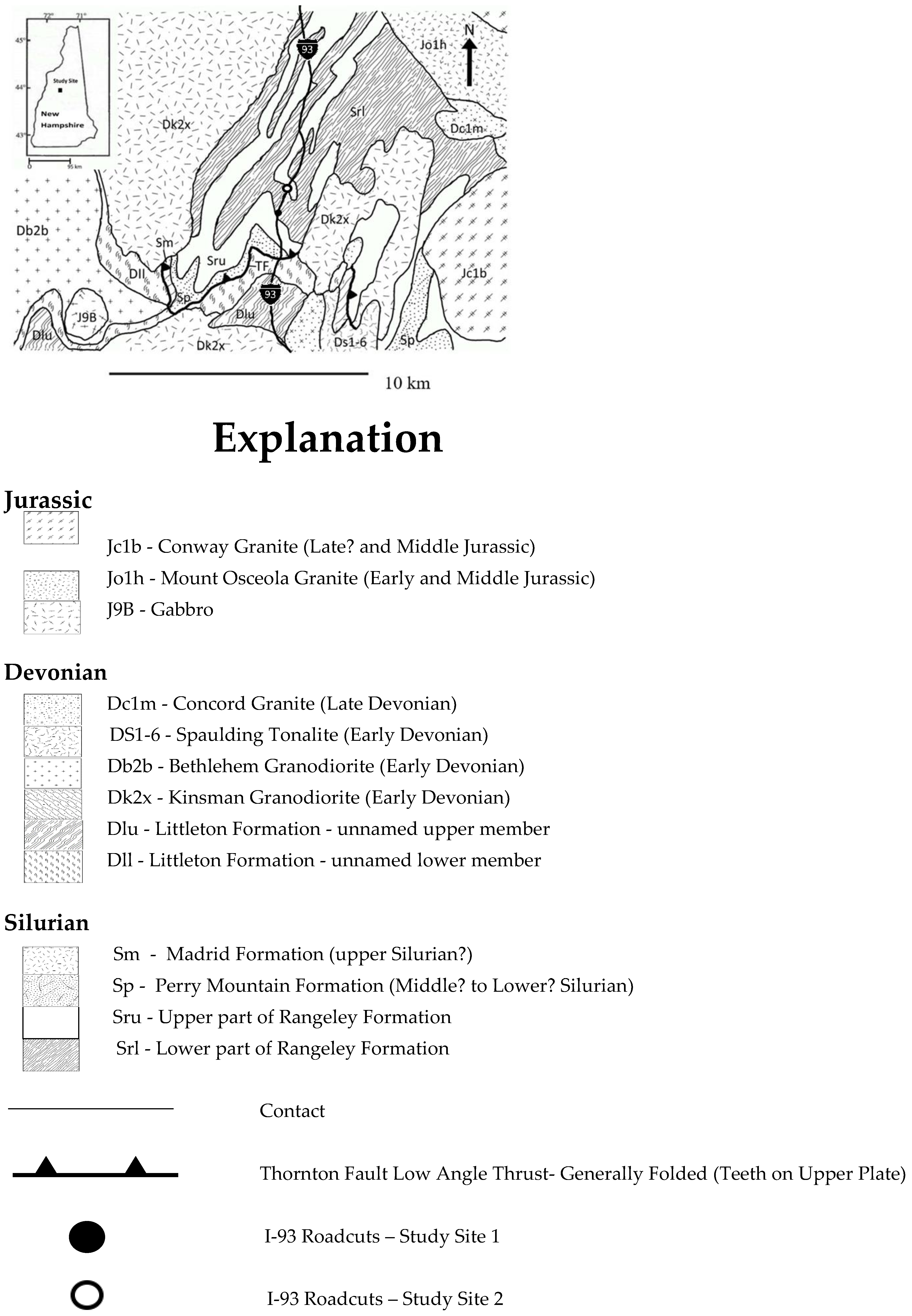
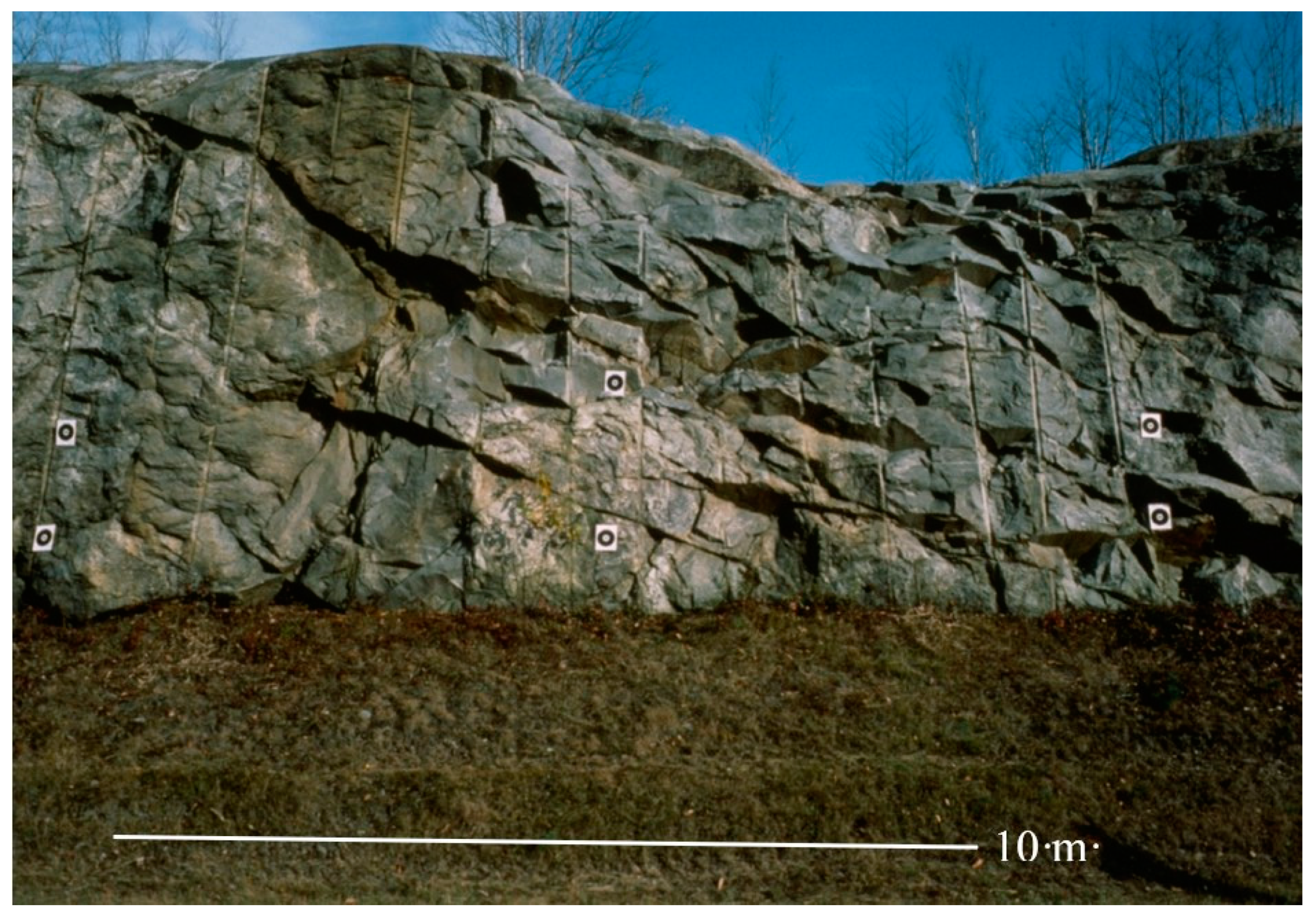
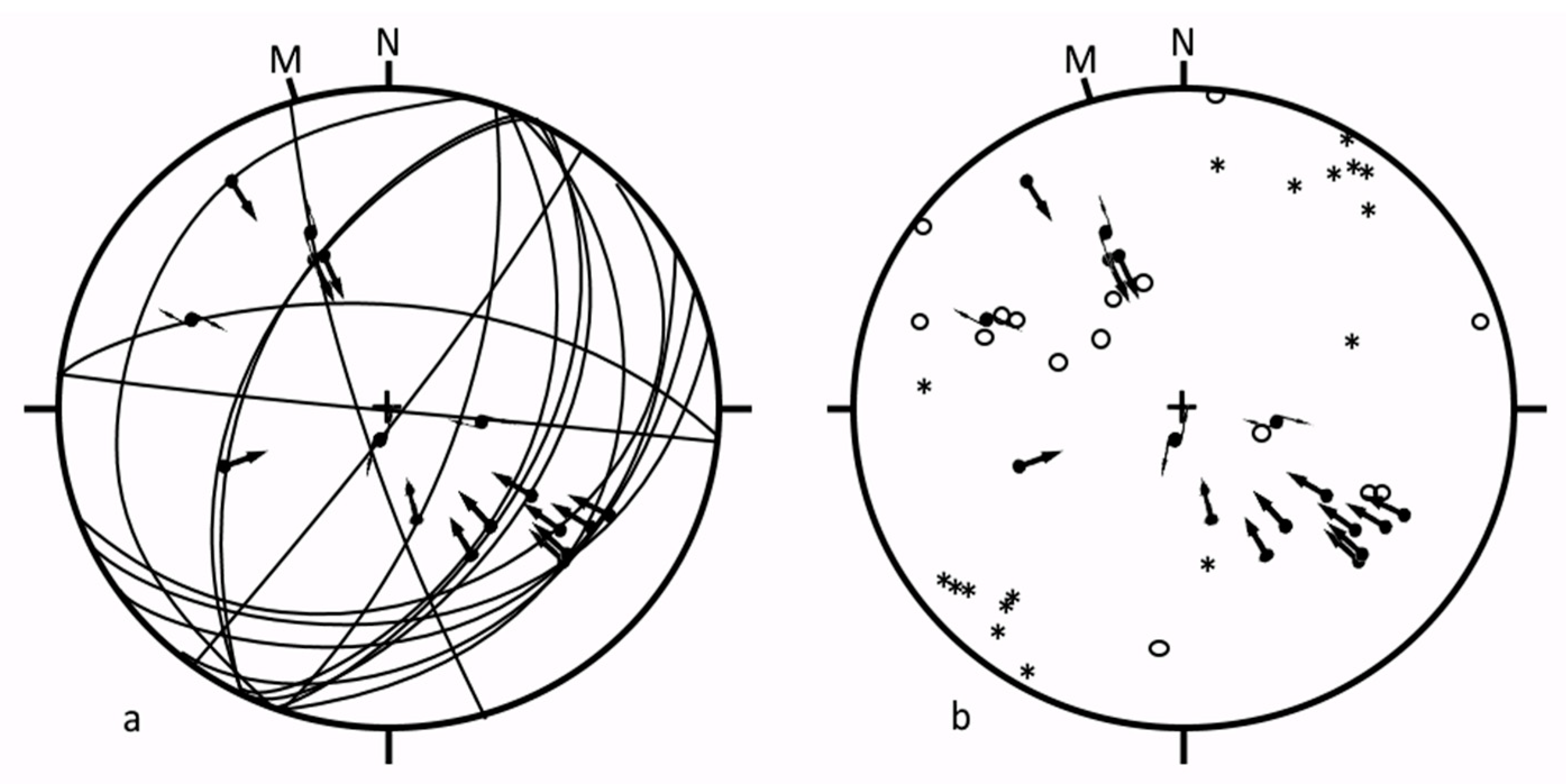
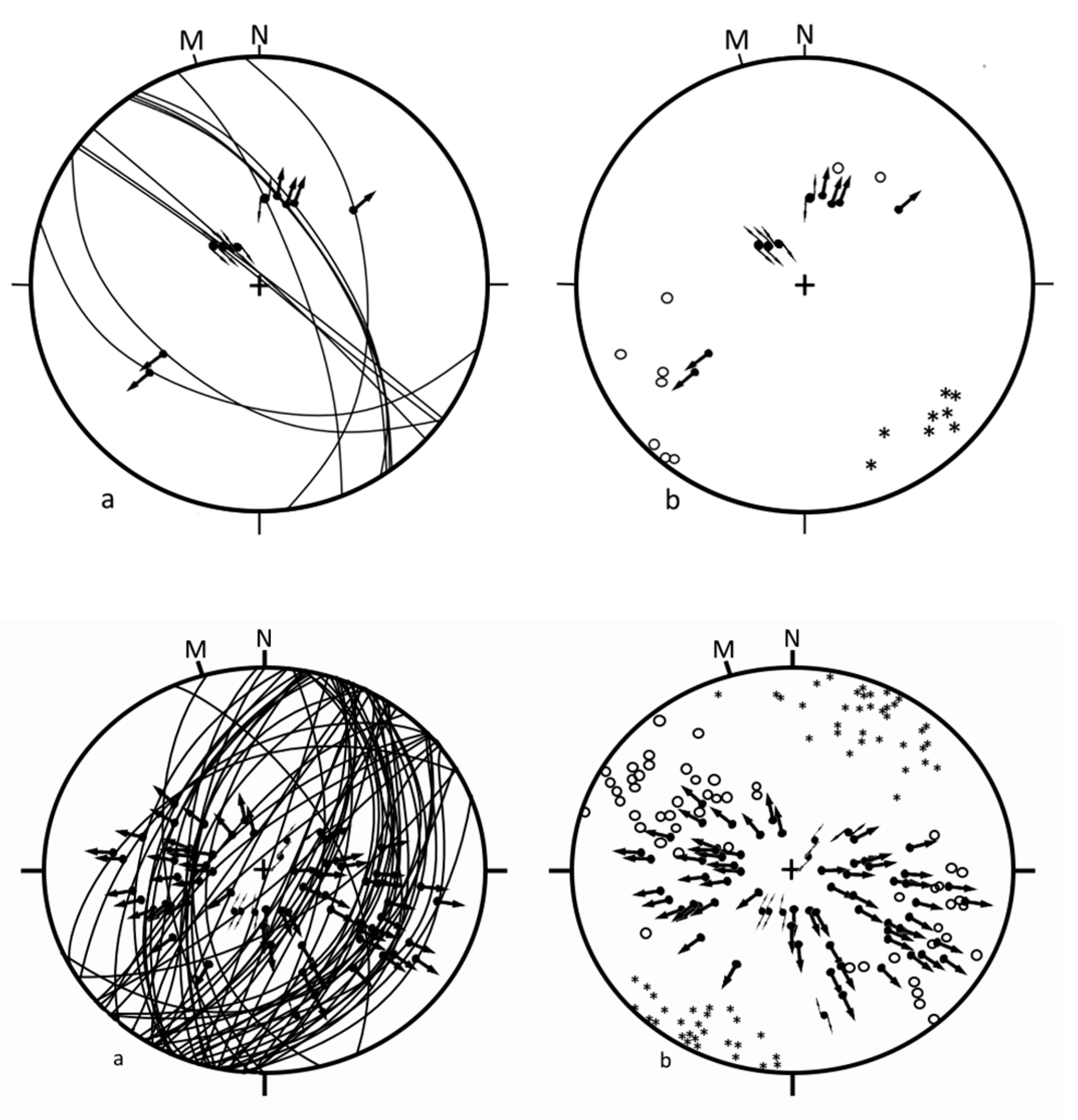
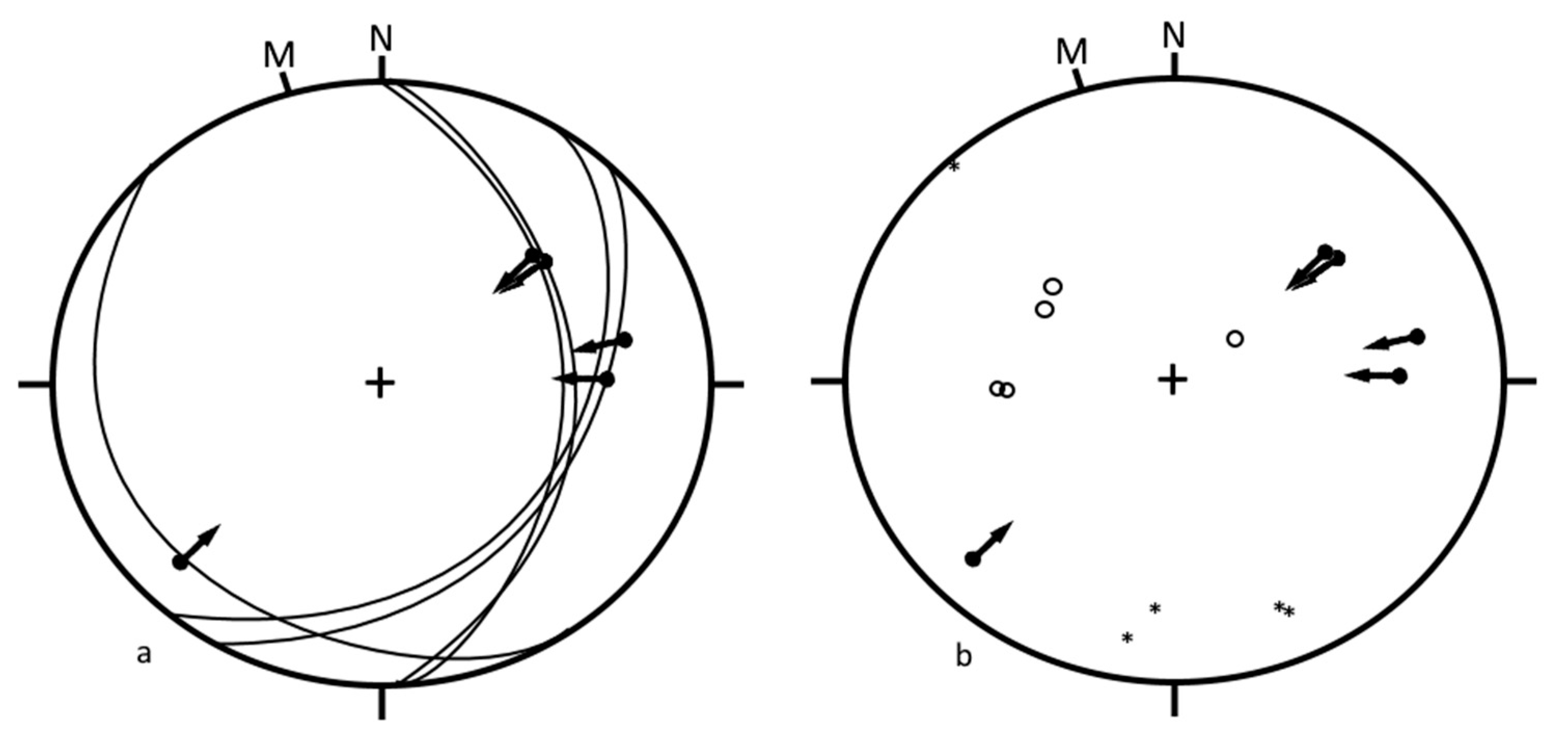
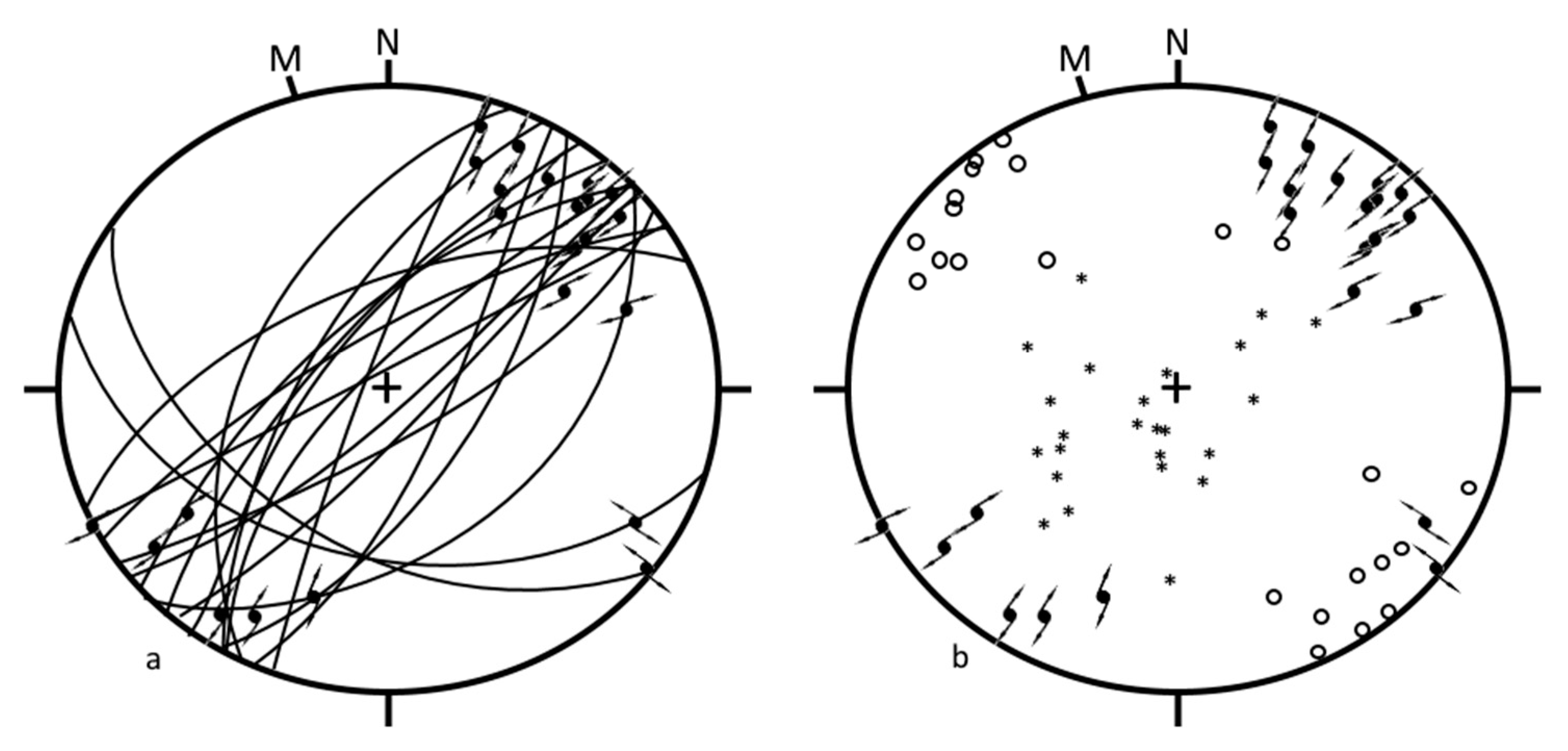

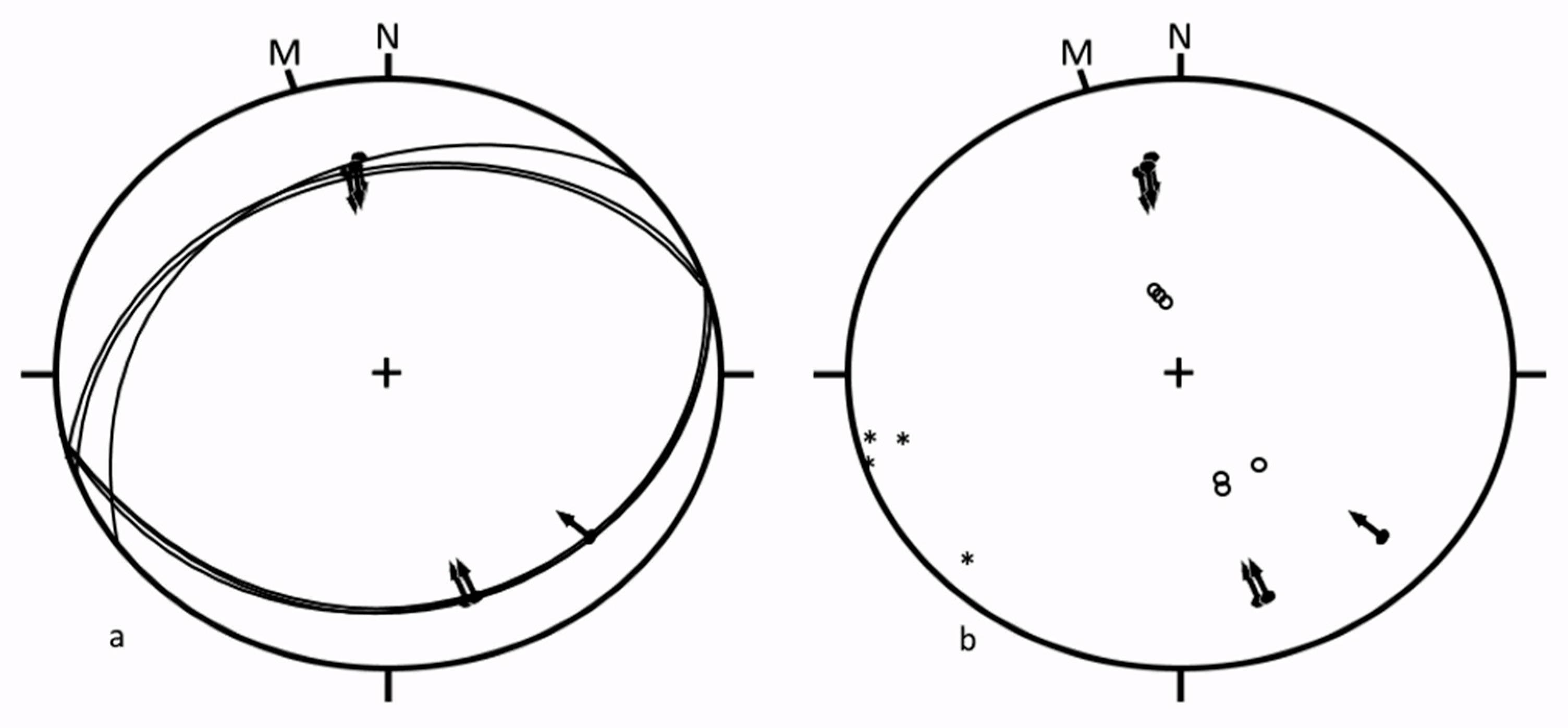
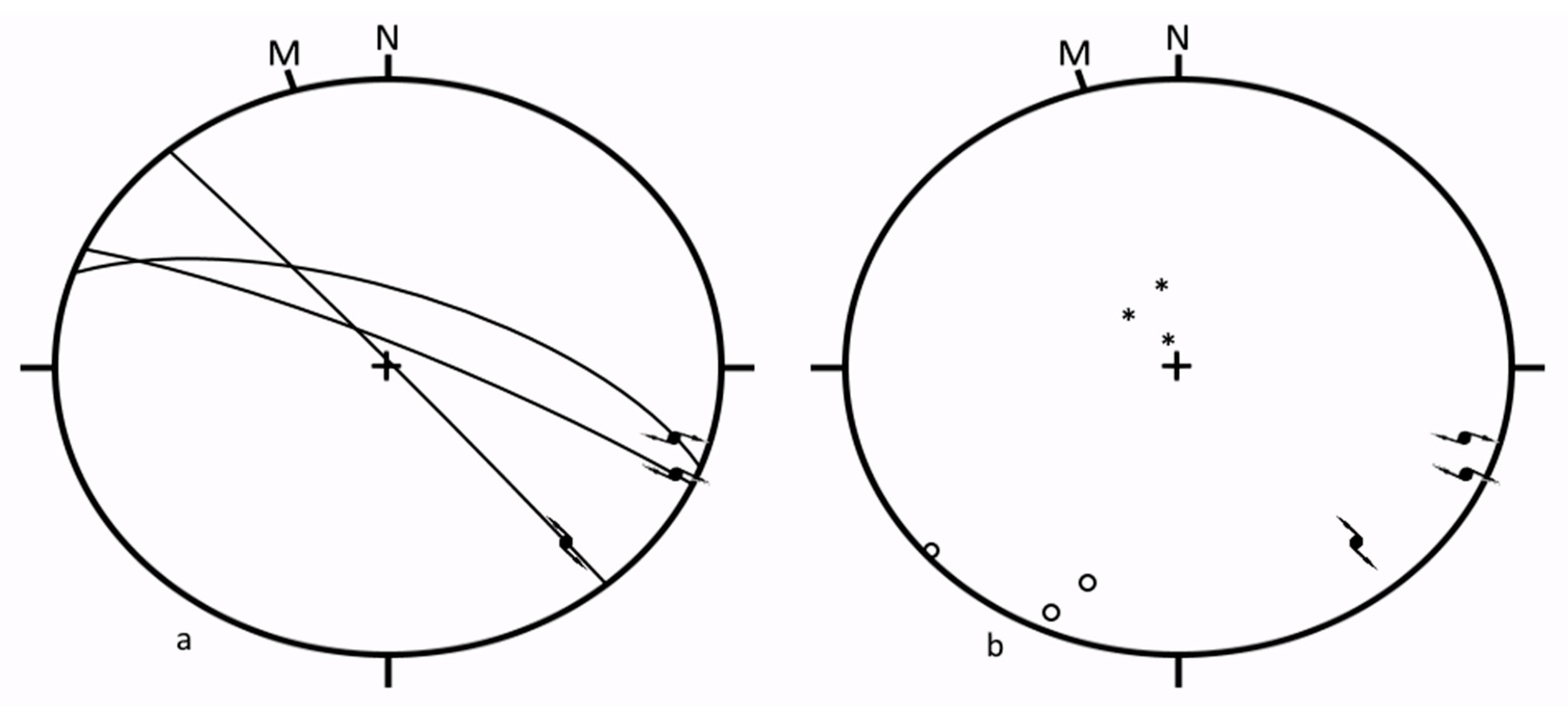
| Reg. | MIFL% | NA | NR | σ1 degrees | σ2 degrees | σ3 degrees | Φ | υm % | τ*m% | αm degrees | |||
|---|---|---|---|---|---|---|---|---|---|---|---|---|---|
| 1 | 40 | 17 | 2 | 133 | 3 | 226 | 45 | 40 | 45 | 0.13 | 75 | 83 | 17 |
| 2 | 55 | 18 | 2 | 257 | 48 | 139 | 23 | 33 | 33 | 0.46 | 86 | 87 | 4 |
| 3 | 40 | 62 | 13 | 184 | 80 | 20 | 10 | 290 | 3 | 0.49 | 79 | 84 | 14 |
| 4 | 45 | 5 | 1 | 239 | 5 | 330 | 8 | 117 | 80 | 0.44 | 70 | 71 | 9 |
| 5 | 55 | 23 | 1 | 83 | 17 | 238 | 71 | 351 | 7 | 0.50 | 80 | 85 | 15 |
| 6–7 | 45 | 52 | 17 | 188 | 14 | 315 | 67 | 93 | 17 | 0.45 | 76 | 79 | 14 |
| 8 | 50 | 6 | 0 | 330 | 7 | 235 | 30 | 72 | 59 | 0.23 | 74 | 77 | 11 |
| 9 | 45 | 12 | 1 | 130 | 5 | 350 | 80 | 40 | 8 | 0.44 | 78 | 78 | 10 |
| Tectonic Events | Time (Ma) | Regime | Fault Type | 1 | 2 | 3 |
|---|---|---|---|---|---|---|
| 1. Compression | 390–375 | 1 | Reverse | 130 | 46 | vertical |
| 2. Extension | 375–325 | 2 3 | Normal Normal | Vertical vertical | 139 20 | 33 290 |
| 3. Compression | 335–260 | 4 5 | Reverse Strike-slip | 239 83 | 330 vertical | Vertical 351 |
| 4. Compression and Extension | 190–95 | 6–7 8 | Strike-slip Reverse | 188 330 | Vertical 235 | 93 vertical |
| 5. Current Compression | 15–present’ | 9 | Strike-slip | 130 | vertical | 40 |
Publisher’s Note: MDPI stays neutral with regard to jurisdictional claims in published maps and institutional affiliations. |
© 2020 by the authors. Licensee MDPI, Basel, Switzerland. This article is an open access article distributed under the terms and conditions of the Creative Commons Attribution (CC BY) license (http://creativecommons.org/licenses/by/4.0/).
Share and Cite
Barton, C.C.; Angelier, J. Direct Inversion Method of Fault Slip Analysis to Determine the Orientation of Principal Stresses and Relative Chronology for Tectonic Events in Southwestern White Mountain Region of New Hampshire, USA. Geosciences 2020, 10, 464. https://doi.org/10.3390/geosciences10110464
Barton CC, Angelier J. Direct Inversion Method of Fault Slip Analysis to Determine the Orientation of Principal Stresses and Relative Chronology for Tectonic Events in Southwestern White Mountain Region of New Hampshire, USA. Geosciences. 2020; 10(11):464. https://doi.org/10.3390/geosciences10110464
Chicago/Turabian StyleBarton, Christopher C., and Jacques Angelier. 2020. "Direct Inversion Method of Fault Slip Analysis to Determine the Orientation of Principal Stresses and Relative Chronology for Tectonic Events in Southwestern White Mountain Region of New Hampshire, USA" Geosciences 10, no. 11: 464. https://doi.org/10.3390/geosciences10110464
APA StyleBarton, C. C., & Angelier, J. (2020). Direct Inversion Method of Fault Slip Analysis to Determine the Orientation of Principal Stresses and Relative Chronology for Tectonic Events in Southwestern White Mountain Region of New Hampshire, USA. Geosciences, 10(11), 464. https://doi.org/10.3390/geosciences10110464




